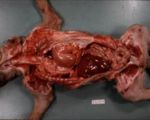Difference between revisions of "Diaphragmatic Rupture"
Jump to navigation
Jump to search
JamesSwann (talk | contribs) |
JamesSwann (talk | contribs) |
||
| Line 1: | Line 1: | ||
{{unfinished}} | {{unfinished}} | ||
| − | + | ==Herniation of Stomach Through Diaphragm== | |
| − | + | ||
| + | * May be congenital or aquired (e.g. after road accident) | ||
| + | ===Clinical=== | ||
| + | [[Image:stomach diaphragmatic hernia.jpg|thumb|right|150px|Displacement of stomach into thorax (Courtesy of BioMed Image Archive)]] | ||
| + | * Causes respiratory distress over several days. | ||
| + | |||
| + | ===Pathogenesis=== | ||
| + | |||
| + | * Common following road traffic accidents in smaller dogs and cats | ||
| + | ** Sudden rise in intra-abdominal pressure ruptures diaphragm, allowing [[Forestomach - Anatomy & Physiology|stomach]] to pass into thorax. | ||
| + | * Also results from kick or severe blow to abdomen | ||
| + | ** Diaphragm splits and [[Forestomach - Anatomy & Physiology|stomach]] forced into thorax. | ||
| + | |||
| + | ===Pathology=== | ||
| + | |||
| + | * Abdominal viscera present in thoracic cavity. | ||
| + | ** Flow of ingesta is disturbed. | ||
| + | ** Thorax is distended and lungs collapse. | ||
| + | * There is a good chance of recovery if the condition is caught reasonably early (before adhesions begin to form). | ||
| + | ** The damage can be repaired.[[Category:Stomach_and_Abomasum_-_Pathology]] | ||
| + | |||
| + | |||
| + | |||
| + | |||
| + | |||
| + | |||
[[Category:To_Do_-_James]] | [[Category:To_Do_-_James]] | ||
Revision as of 12:03, 6 July 2010
| This article is still under construction. |
Herniation of Stomach Through Diaphragm
- May be congenital or aquired (e.g. after road accident)
Clinical
- Causes respiratory distress over several days.
Pathogenesis
- Common following road traffic accidents in smaller dogs and cats
- Sudden rise in intra-abdominal pressure ruptures diaphragm, allowing stomach to pass into thorax.
- Also results from kick or severe blow to abdomen
- Diaphragm splits and stomach forced into thorax.
Pathology
- Abdominal viscera present in thoracic cavity.
- Flow of ingesta is disturbed.
- Thorax is distended and lungs collapse.
- There is a good chance of recovery if the condition is caught reasonably early (before adhesions begin to form).
- The damage can be repaired.
